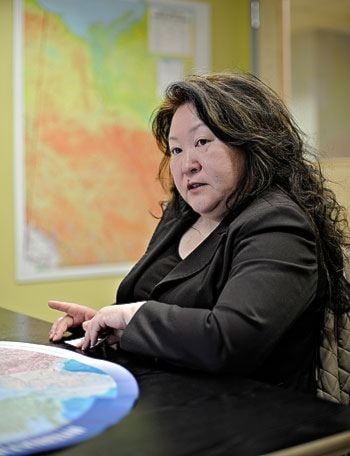The permafrost-addled stretch of Alaska Highway near Beaver Creek is a landmark that most tourists try to avoid, but not Larisa Ivanova.
It’s actually what the Russian civil engineer came to the Yukon to see.
Ivanova was in the territory for a two-week course at Yukon College on permafrost engineering.
It’s usually offered in the spring to about 20 students and professionals, but the college made a special exception so Ivanova could take the course.
The Sakha Republic in the far east of Russia, where Ivanova comes from, faces many of the same challenges as the Yukon when it comes to road construction.
They study permafrost there, but there is nothing like the research project going on at Beaver Creek right now, said Ivanova through a translator.
In 2008, two professors - Guy Dore from Laval University and Chris Burn from Carleton - built a research station along 600 metres of highway near Beaver Creek.
That stretch of road, like about one-quarter of the territory’s 4,800 kilometres of highway, is built on permafrost - ground that stays frozen for two years or more.
The problem with permafrost is that it can be unstable. Building a road on it can cause the permafrost underneath to melt.
As the subsurface melts, it causes the road to warp and crack, which makes it very expensive to keep up.
It costs about eight times more to maintain a road built on permafrost.
The 11 different techniques being studied at the Beaver Creek research station are all designed to try to keep the ground underneath the road from melting.
The early research has shown that three of those techniques are very promising, said Julie Lepage, a graduate student who has been working on the project since 2010.
[image2]
An air-convection embankment uses large rocks to create air cells. A longitudinal culvert involves drilling holes under the road, to trap cold air while allowing warm air to escape.
The third technique simply involves paving the road with a light-coloured bituminous surface treatment, or BST, which stays cooler by reflecting sunlight.
BST, what most people call chip-seal, is used on most of the Yukon’s highways.
The mixture of gravel and asphalt is more flexible and easier to maintain than traditional asphalt, although it doesn’t last as long.
Using a lighter-coloured BST hasn’t been tried outside of the Beaver Creek research station, but it’s something that is being considered, said Paul Murchison, the director of transportation engineering for the Department of Highways and Public Works.
It wouldn’t be hard to do.
“The only difference is we’d have to load trucks with light-coloured gravel,” he said.
But just regular old black BST was one of the things that impressed Ivanova most about the Yukon.
In Russia, BST is not used at all.
Roads there are made out of either a mixture of concrete and asphalt or plain old gravel, she said.
The first has a tendency to crack in cold weather while the gravel creates dust problems in the summer.
“It is really hard to drive during the summer, because with the dust clouds you can’t see anything at all,” said Ivanova.
When she heads back to Russia, her first stop will be in Moscow where she will deliver a report on what she learned here in the Yukon.
Her hope is that Russia will be able to send some engineers here this spring to take the Yukon College course and to share information about road construction with their Yukon government counterparts.
The Russians are not the only ones that are interested in this course, said Stephen Mooney, the director of cold climate innovation at the Yukon Research Centre.
“We had a Danish student take the course, and two Chinese students tried to take the course but they couldn’t get their visas,” he said. “We’re hoping they’re going to make it this year.”
Just this week he got an email from a Norwegian student asking about it.
Yukon College is right on the cutting edge when it comes to this kind of research, said Mooney.
“We have quite a bit of knowledge of permafrost that I thought was common knowledge around the circumpolar world, but when I went and we did a tour of Scandinavia I found out pretty quick that they didn’t know a lot about permafrost, yet they live in a permafrost-rich environment,” he said.
Also, being able to offer doctoral-level credits is a big achievement for a humble college, said Mooney.
“You can’t get your master’s in highway design from Yukon college, but this course is in partnership with Laval, and it is for students at the highest level of highway design in Canada. So this is incredibly unique that the college, being a college not a university, is delivering a master’s- and doctorate-level course in anything.”
Contact Josh Kerr at
joshk@yukon-news.com
